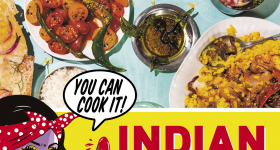Hello, Hyphen readers.
Welcome to my new column. I am Meeta Kaur, and I live in the San
Francisco Bay Area with my husband, Banjot Chanana, and our two children,
Benanti and Sidak. We are a Sikh American
family that strives toward balanced days of work and play. Slowing down to understand what matters has
been the best compass for us. And humor
seems to be the key to it all: whether it is twenty-month-old Sidak showing us
his Incredible Hulk impression, Benanti making up variations to the funky-chicken
dance, or Banjot reverting to his college French accent when reading bedtime stories,
we tee-hee and titter our way through it all.
For my blog posts, I plan to draw inspiration from
my roles as a life partner, mother, friend, creative writer, community advocate,
and second generation Sikh American. The
intersection of these identities drives me to explore subjects that impact my
personal, family, and community life. From school bullying and hate crimes against Sikh Americans to the
inspiration that mothers draw from the inherent tension between parenting and
art, life has a way of posing timely
questions at the kitchen table for a conversation. And I hope these blog posts become just that:
kitchen table conversations that we can engage in together.
* * *
A memorable visit to our pediatrician’s office last
year had me questioning my role and my entire approach to parenting and
food. Benanti, our five-year-old
daughter, was diagnosed as creeping dangerously close to the obesity range on
her growth chart. This conversation unnerved
me, given the media attention towards the childhood obesity epidemic in the
US. The statistics about
childhood diabetes and future risk of heart disease, cholesterol, and adult
diabetes sent my husband and I into a frenzy.
That same week, we put Benanti on a restricted diet,
eliminating carbs and sugar. We
controlled Benanti’s portions at the dinner table and forced her to go outside
and play. We watched her like hawks: every
morsel, every crumb that passed her lips. The result? She despised our
behavior and did not hesitate to let us know. Miserable child. Miserable family.
In our desire to protect our child from what might
be her natural weight and height, in favor of a vague but clinically dangerous
area on her growth chart, we robbed our
child of the pleasure of eating good food. We distorted her relationship to food. And we stopped trusting ourselves as parents.

photos courtesy of the author
This experience led me to a search for a cooking
and feeding relationship that nourished my children, and preserved the joy and
discovery of eating food. I had to pause
and examine the media and societal messaging I received about food and body
image, food and deprivation, food and its uses as an emotional crutch. I knitted together various sources of
information and created a balanced approach to cooking and serving food that
draws from multicultural practices and wisdom.
At the time, our diet was not horrible and could
even be considered healthy as far as American diets are concerned. But that was just it. We weren’t tapping into the wealth of
nourishing food that comes from South Asian and broader Asian cultures as
frequently as we could have. We resorted
to quick and easy food, treating meals as something we could not be bothered
with: cereal and eggs for breakfast,
macaroni and cheese for lunch, chicken and rice for dinner. And every now and then, we’d throw in a vegetable! We occasionally cooked Punjabi food, but we
weren’t thinking through the full range of choices children need at each
meal: a protein, two carbohydrates, a
vegetable, a fruit, a fat source, and some milk for growing bodies. And we also neglected to implement a
time-table for structuring meals and snacks, to prevent hunger and sugary
cravings from hunger.
For Asian American families, family meals and food
are embedded within cultural custom, holidays, and family celebrations. When
food is served to be enjoyed, shared, and celebrated, the family space becomes
a safe space to share ourselves and how we connect to our greater family
histories.
I also realized that my first-generation immigrant Punjabi
mother and father gave me all the tools I needed to feed my children: food that tied us to family generations, serving
food in abundance, and compassion in the serving process. My mother’s and grandmother’s khana (prepared food) provided all the nutrients, flavor, and
satisfaction I needed to have autonomy over my own plate as a child while
developing a healthy relationship with food.
Reconnecting back to cultural foods that were
staples in my own household provided Benanti the balance with vegetables,
proteins, and carbs to eat nutritionally and be satisfied. I tuned into her instinctual cravings for gobi prontis, cauliflower stuffed wheat
breads, rajma and chawal, red beans
and rice, and masala chicken to give her foods her body naturally craved and
desired.
The preparation of family meals has
become one of our favorite ways to spend time together. Banjot and I appreciate Benanti and Sidak’s
desires to be apprentice chefs, baking banana bread, making omelets, or
smashing avocados for guacamole. It
gives them purpose, pride, and ownership over the meals that are served. Most
importantly, they are enjoying their
food with no restrictions while
nourishing their growing bodies.
A Quick and Easy Recipe for Bhangan (Stir-Fried
Eggplant):
1 yellow onion
2 roma tomatoes
2 eggplants
2 Tbs olive oil
2 tsp salt
1 tsp red pepper
Slice the onion into long pieces. Then chop the
tomatoes and set aside. Wash the
eggplant and slice into discs. Place into a bowl and microwave for 4-6 minutes
to soften. Set aside eggplant. Take a fry pan and coat pan with olive oil on
medium heat. Place sliced onions and
cook until golden brown. 5-6 minutes. Then add eggplant, chopped tomatoes,
salt, and red pepper. Cook on medium-low heat until eggplant is cooked down and
merges with tomatoes and onions. 25-30
minutes. You can also wait until the eggplant caramelizes a bit for a roasted,
oven taste. Taste eggplant for salt.
Serves 3-4 people. Enjoy with chapaati or a warm wheat tortilla, plain
yogurt or greek yogurt, and a side salad of sliced cucumbers, onions, carrots,
and radish. Sprinkle salt, pepper, and squeeze lemon onto salad.
Enjoy with loved ones!










Comments